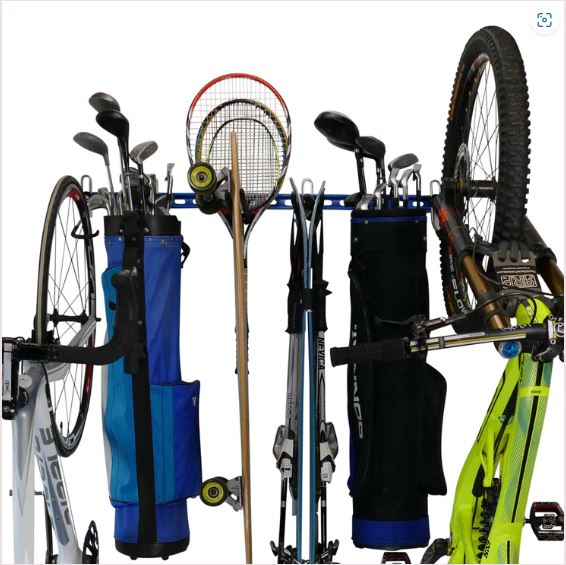
How to Store Your Pickleball Gear (and any other sports gear) and Keep It Safe
Share
Pickleball paddles, balls, and other accessories are investments that can degrade quickly if not cared for properly. Storing any sports equipment correctly can extend its lifespan, keep it in top condition, and be ready to play whenever the opportunity arises.

Photo by Aleksander Saks on Unsplash
Common Challenges in Storing Pickleball Equipment
Storing pickleball gear, and indeed any kind of sports equipment, presents several challenges. One major issue is space constraints; limited storage space can make it difficult to keep all your equipment organized and accessible.
Environmental factors also pose a significant challenge. Exposure to extreme temperatures, humidity, and sunlight can damage your gear.
Frequent use can lead to wear and tear, which can be exacerbated by improper storage. Addressing these challenges through effective storage solutions can help maintain the quality and longevity of your equipment.
Cleaning and Maintaining Sports Equipment Before Storage
Cleaning your gear before storage is crucial to prevent dirt and grime from causing long-term damage. Here are the steps:
- Paddles: Use a damp cloth to wipe down the paddle surface and edges. For stubborn dirt, use a mild soap solution. Avoid soaking the paddle in water. After cleaning, dry it thoroughly with a towel.
- Balls: Wash pickleball balls in a mild soap solution to remove dirt and debris. Rinse them well and dry them completely before storing.
- Other Gear: Clean shoes, bags, and accessories according to the manufacturer’s instructions. Use a brush to remove dirt from shoes, and wipe down bags with a damp cloth.

Photo by Aleksander Saks on Unsplash
Drying your equipment thoroughly is essential to prevent moisture-related damage, such as mould, mildew, and rust. After cleaning, ensure that all components are completely dry before storing them. Moisture can weaken materials and reduce the lifespan of your gear.
Optimal Storage Conditions
Ideal Temperature and Humidity Levels
To keep your pickleball gear in top condition, store it in an environment with stable temperature and humidity levels. Ideally, the temperature should be between 50°F and 70°F (10°C to 21°C). Avoid areas that experience extreme heat or cold, such as garages or attics.
Maintaining low humidity levels is crucial to prevent moisture damage. A relative humidity level of 30% to 50% is ideal, and using a dehumidifier in areas prone to high humidity can be beneficial.
Exposure to direct sunlight and moisture can cause significant damage to pickleball gear. Sunlight can fade and weaken materials, while moisture can lead to mold and mildew growth.
To protect your equipment, keep it indoors, away from windows and areas prone to dampness. Using covers or cases for your paddles and bags can also help shield them from dust and light.
Using Pickleball Gear Organizers
Benefits of Sports Gear Organizers
Using gear organizers for your sports equipment offers several advantages:
- Organization: Keeps all your gear in one place, making it easy to find and access.
- Protection: Prevents damage by keeping items separated and secure.
- Space Efficiency: Helps utilize space more effectively, especially in limited areas like closets or garages.
- Convenience: Makes it simple to grab your gear and go, ensuring everything is ready for your next game.
GearHooks Sports Equipment Storage Rack
Types of Organizers
- Bags: Specialized pickleball bags come with compartments for paddles, balls, and accessories. They are portable and convenient for transport.
- Racks: Wall-mounted or freestanding racks provide a dedicated space for storing paddles and balls at home.
- Shelving Units: Multi-tiered shelves can hold larger quantities of equipment and accessories, ideal for players with extensive gear.
Storing Pickleball Paddles
To maintain their shape and avoid bending, store paddles upright in a rack or bag. Avoid stacking heavy items on top of your paddles or placing them in tight spaces where they can get squeezed or scratched.
Ensuring adequate ventilation is also important to prevent moisture build-up, which can damage the paddles' surface and core.

Photo by Aleksander Saks on Unsplash
Protective covers and cases offer an additional layer of protection for your paddles. They shield the paddle face from scratches and dings, protect against impacts, and extend the lifespan of your paddles. Many cases also have compartments for storing balls and accessories, making it easier to keep everything together.
Storing Pickleball Balls
Proper storage of pickleball balls ensures they remain in good condition for play. Here are some best practices:
- Cool and Dry Location: Store balls in a cool, dry place to prevent them from becoming brittle or losing their bounce.
- Avoid Direct Sunlight: Exposure to sunlight can degrade the material of the balls, affecting their performance.
- Use a Container: Keep balls in a container or a mesh bag to protect them from dust and damage.

Photo by Aleksander Saks on Unsplash
Organizing and Maintaining Ball Condition
- Container Storage: Use a dedicated container or a mesh bag to store balls, keeping them organized and easy to find.
- Regular Inspection: Check balls periodically for cracks or signs of wear. Remove damaged balls to ensure you're always playing with quality equipment.
- Rotation: Rotate the use of your balls to ensure even wear and extend their lifespan.
Storing Other Sports Accessories
Proper storage of your pickleball accessories is essential for maintaining their condition and ensuring they are always ready for use. Here are some tips:
- Shoes: Store your pickleball shoes in a cool, dry place. Use shoe bags or boxes to keep them protected from dust and dirt. Avoid placing heavy items on top of them to prevent deformation.
- Apparel: Keep your pickleball apparel clean and dry. Fold clothes neatly and store them in drawers or on shelves. Use moisture-absorbing packets to prevent mold and mildew in humid environments.
- Other Accessories: Items like wristbands, hats, and towels should be stored in breathable bags or containers. Ensure these accessories are dry before storing to avoid mildew and odors.

Photo by cottonbro studio: https://www.pexels.com/photo/woman-in-red-shirt-leaning-on-tennis-net-5740812/
To keep your gear organized and accessible, create a designated area for all your pickleball equipment, such as a shelf, closet, or storage bin.
This helps maintain order and makes it easy to find everything. Using labels on boxes and containers allows you to identify contents quickly.
Installing hooks and hangers for items like bags, hats, and jackets keeps them off the floor and within reach.
Wrapping Up
Proper storage of your pickleball gear is essential for maintaining its condition and ensuring it performs well when you need it. Follow these guidelines and you can enjoy your investment for years to come and always be ready for your next match on the court.


